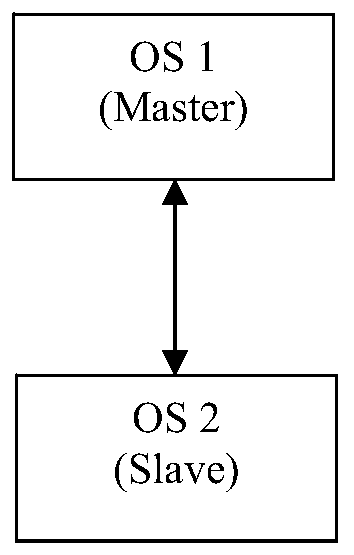Operating system clock synchronization method and system under 2oo3 redundant structure
A redundant structure and operating system technology, which is applied in the field of network information transmission, can solve problems such as high environmental requirements, low synchronization accuracy, and many constraints, and achieve the effect of optimizing task scheduling and ensuring consistency
- Summary
- Abstract
- Description
- Claims
- Application Information
AI Technical Summary
Problems solved by technology
Method used
Image
Examples
Embodiment 1
[0110] in a such as figure 1 In the shown network, there are two slave clock nodes and one master clock node, and all three nodes are running normally. At a certain moment, the master clock follows the IEEE1588 standard to send a synchronization signal, and one of the slave clocks performs the following synchronization process after receiving the synchronization signal:
[0111] Step 1: The Ethernet controller module receives the synchronization message from the master clock, reads the clock information in the high-precision clock module, calculates the clock difference to get -10ms, and transmits the clock difference to the synchronization controller module.
[0112] Step 2: The synchronization controller module receives the clock difference, and its absolute value is greater than the maximum tolerance difference of 1ms, so the system clock status of the node is changed from Running&Synchronous to Running and the -10ms clock difference is passed to the synchronization adjustm...
Embodiment 2
[0116] in a such as figure 1 In the shown network, there are two slave clock nodes and one master clock node, and all three nodes are running normally. At a certain point, a slave clock node restarts due to a failure, and rejoins the node after the restart is complete and synchronizes. The slave clock performs the following synchronization process:
[0117] Step 1: After a new node is added, the synchronization controller sets the node status to Stopped, waiting for synchronization with the main clock.
[0118] Step 2: The Ethernet controller module receives the synchronization message from the master clock, reads the clock information in the high-precision clock module, calculates the clock difference to obtain 900ms, and transmits the clock difference to the synchronization controller module.
[0119] Step 3: The synchronization controller module receives the clock difference, which is greater than the maximum tolerance difference of 1ms, so the system clock status of the ...
Embodiment 3
[0123] The operating system clock synchronization system under the 2oo3 redundant structure of the present invention is divided into a high-precision clock module, an Ethernet controller module, a synchronization controller module, a synchronization adjustment module and a system clock module. create a like figure 1 Synchronous network shown.
[0124] The high-precision clock module provides high-precision external clock data, and uses the IEEE1588 protocol to synchronize with the high-precision clock module of the main clock node in the network.
[0125] The Ethernet controller module is used to communicate with other nodes in the network, transmit synchronization messages conforming to the IEEE1588 protocol, and transmit the clock difference to the synchronization controller module.
[0126] The synchronization controller module receives the clock difference data from the Ethernet controller module, analyzes the difference data and manages the system clock status of the loc...
PUM
 Login to View More
Login to View More Abstract
Description
Claims
Application Information
 Login to View More
Login to View More - R&D
- Intellectual Property
- Life Sciences
- Materials
- Tech Scout
- Unparalleled Data Quality
- Higher Quality Content
- 60% Fewer Hallucinations
Browse by: Latest US Patents, China's latest patents, Technical Efficacy Thesaurus, Application Domain, Technology Topic, Popular Technical Reports.
© 2025 PatSnap. All rights reserved.Legal|Privacy policy|Modern Slavery Act Transparency Statement|Sitemap|About US| Contact US: help@patsnap.com



